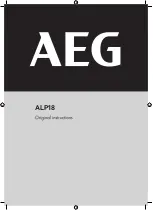
408-2363
3 of 4
Rev J
3. Make certain all pins, pivot points, and bearing
surfaces are protected with a THIN coat of any good
SAE 20 motor oil. DO NOT oil excessively.
4. When the tool is not in use, keep the handles
closed to prevent objects from becoming lodged in
the crimping dies. Store the tool in a clean, dry area.
4.2. Periodic Inspection
Regular inspections should be performed by quality
control personnel. A record of scheduled inspections
should remain with the tool and be supplied to
personnel responsible for the tool. Though
recommendations call for at least one inspection a
month, the inspection frequency should be based on
the amount of use, ambient working conditions,
operator training and skill, and established company
standards. These inspections should be performed in
the following sequence:
A. A.Visual Inspection
1. Remove all lubrication and accumulated film by
immersing the tool (handles partially closed) in a
suitable commercial degreaser that will not affect
paint or plastic material.
2. Make certain all retaining pins are in place and
secured with retaining rings. If replacements are
necessary, refer to Section 5, REPLACEMENT
AND REPAIR.
3. Close the tool handles until the ratchet releases,
then allow handles to open freely. If they do not
open quickly and fully, the spring is defective and
must be replaced. See Section 5, REPLACEMENT
AND REPAIR.
DO NOT CONTINUE TO SQUEEZE THE TOOL
HANDLES AFTER THE RATCHET RELEASES.
Damage will occur to the tool if the ratchet is forced
against the stop pin.
4. Inspect the head assembly, with special
emphasis on checking for worn, cracked, or broken
jaws. If damage to any part of the head assembly is
evident, the tool must be evaluated and repaired.
See Section 5, REPLACEMENT AND REPAIR.
B. Jaw Closure Inspection
This inspection requires the use of a plug gage
conforming to the dimensions in Figure 5. Proceed as
follows:
1. Knock out the roll pins securing dies to jaws, then
remove dies.
2. Close the tool handles to the last notch on the
ratchet (the handles will automatically open if they
are closed beyond this point).
3. Align the GO element with the tool jaws. Push the
GO element straight into the jaw closure without
using force. The GO element must pass completely
through the jaw closure as shown in Figure 5.
4. Align the NO-GO element with the jaw closure
and try to insert it into the jaw closure. The NO-GO
element may start entry but must not pass
completely through the jaw closure as shown in
Figure 5.
5. Re-install the dies and secure them with the roll
pins.
If the jaw closure conforms to the gage inspection, the
tool is considered dimensionally correct and should be
lubricated with a THIN coat of any good SAE 20 motor
oil. If not, the tool must be repaired before returning it
to service (see Section 5, REPLACEMENT AND
REPAIR).
C. Ratchet Inspection
This inspection requires the use of a plug gage
conforming to the dimensions in Figure 5. Proceed as
follows:
1. Knock out the roll pins securing dies to jaws,
remove dies, then insert the NO-GO element
between tool jaws.
Figure 5
CAUTION
!
PLUG GAGE DIMENSION
GO ELEMENT
NO-GO ELEMENT
6.680-6.688 [.2630-.2633]
7.059-7.061 [.2779-.2780]
Suggested Plug Gage Design
76.2 [3.00]
4.8 x 4.8 [.19 x .19]
(45° Ref)
4.8 [.19]
NO-GO
Dim.
GO
Dim.
Gaging the Jaw Closure
Jaw
Closure
Jaw
Closure
GO Element
NO-GO Element
GO element must pass
completely through jaw
closure.
NO-GO element may enter
partially, but must not pass
completely through jaw closure.
Radius
NO-GO
GO






















